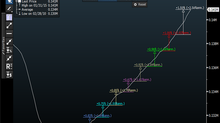About Those "Discouraged Workers"
Whenever there is a discussion about the employment (or unemployment) situation, someone will chime in with "What about "discouraged workers?" One economist, Roger E.A. Farmer, thinks there's no such thing as a "discouraged worker" and while I wouldn't go that far, he has a point.
Finding a job for someone who was let go or faced a sudden crisis in their work life may indeed find it hard to land a new position even if the labor economy is on fire and the monthly employment numbers are something to celebrate. But people have these ideas about how labor markets sort and clear that is completely detached from reality.
As I've written before, even if the BLS reports the economy added say, 500,000 jobs, looking under the surface shows that can mean 2 million people found jobs while 1.5 million lost them. This is perfectly normal and while the hard numbers will vary month to month, this is ordinary, bread and butter labor market churn in a workforce of 160 million people. Everyone focuses on the net gain or loss in job creation, but underneath even a strong gain, people can and do lose jobs in large numbers for a variety of reasons. Some are layoffs, which lately are rare, and some are "voluntary separations," as the BLS calls them, but nevertheless, newly unemployed workers may find it difficult to place themselves.
So, think of the workforce as a giant hotel: people are constantly checking in and checking out.
Workers may struggle for months without finding anything suitable, but one thing the BLS doesn't count is just how much of an effort they're making. But even those who make a mighty effort may find themselves frustrated and could become "discouraged." But how many are there?
And how does the BLS define a "discouraged worker?"
"Discouraged workers (U-4, U-5, and U-6 measures) are persons who are not in the labor force, want and are available for work, and had looked for a job sometime in the prior 12 months.
The U-4 rate includes discouraged workers; thus, the difference between U-3 and U-4 reflects the degree of would-be job-seeker discouragement. At the national level, the difference between U-3 and U-4 was +0.2 percentage point through the four quarters ending in September 2022. No state had a noteworthy difference between these two measures."
Charting out that last sentence looks like this:

I've deliberately elongated the height of the chart so the thin spread between U-3 (the headline unemployment rate) and U-4, shown by the Black line (which is U-3 PLUS "discouraged workers") can be seen for the minor slice of the workforce the discouraged actually make.
Going back to Farmer's point about there being no such thing as a "discouraged worker," it comes down to the definition that the BLS is calling anyone who has looked for a job in the past full year as "discouraged," but in reality, those people might have other issues on their plate, like a health problem that has to be tended to, or perhaps a housing situation that may prevent them from making any hard commitments.
But Farmer's main point is basically street smarts: "Ya gotta eat," so even if it's tough landing a job, you may give up for a short time in frustration, but not for a whole year.
So the main point of this piece is that there are not millions of sad eyed "discouraged" workers wandering our streets in frustration, and even if the public's imagination was correct, it would not come to a significant portion of the American workforce.
Let's bury another myth, shall we?
11/28/2022













